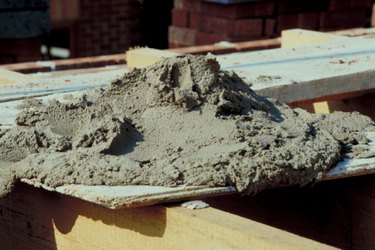
Portland cement is made up of a number of compounds but primarily consists of limestone and clay. It can be mixed with water, sand, and other materials for use in building and sculpting projects. Portland cement is so named because the color of the cement is akin to the limestone from the Isle of Portland in the English Channel.
How to Mix Portland Cement and Sand for Flooring
Video of the Day
When mixed with sand, Portland cement becomes an excellent material for skim coating concrete to repair cracks and pits, leveling a floor, or creating a bed of mortar for tile. Employ the following steps for the best results:
Video of the Day
- Determine the square-foot area and the thickness of your flooring project to calculate the quantity to mix.
- In a mixing container, add no more than 1 part cement to 2 parts sand. For some applications, you may add up to a 1:8 ratio of cement to sand. More cement means more strength and stickiness but less workability. Ratios with more cement than a 1:2 ratio with sand will prove difficult to work with and some of the aggregate may not bind correctly. A 1:8 ratio of cement to sand will be workable and dry slowly to buy you time but will be less strong than a mix with more cement.
- Add hydrated lime to the mixture to reduce shrinkage cracks. It will also make the mortar more waterproof. If you add lime, the mixing ratio will be roughly 1:6:15 of lime, cement, and sand.
- Mix the ingredients together and add water until the mix reaches a thick, creamy consistency.
How to Mix Portland Cement and Sand for Concrete
Mixing Portland cement, sand, and larger aggregates such as gravel with water makes concrete. The mix is common for use in everything from sidewalks to building construction. Here's a simple recipe to make concrete using Portland cement and sand:
- Determine how many cubic feet of concrete your project requires.
- Add a ratio of 1 part cement to 2 parts sand and 3 parts gravel to a mixing container for most practical uses.
- Add 0.5 part water slowly to the container while mixing.
Make Sculptures with Portland Cement and Sand
The rules for Portland cement in construction applications go out the window when it comes to its applications in the art world. There are numerous mixing variables and compounds you can add to change the characteristics of the medium. Even making lightweight concrete is possible.
The best ratio for making sculptures is 1 part silica sand to 2 parts cement, 1 part latex, a small amount of microfibers, and 4 parts water. The combination will give you a mixture that is the consistency of clay.
For mold-poured sculpting, you may opt for a mix of up to 3 parts cement to 1 part sand. Larger art structures may require adding gravel of various sizes to strengthen to the finished product.
Here's how to mix Portland cement and sand to make sculptures:
- Mix dry ingredients in a mixing container.
- Add water slowly until the mix reaches an appropriate consistency for your project.
Tip
Only mix as much as you can use in two hours. Do not add water to the mixture if it starts to get hard.
What Is Portland Cement?
Portland cement is the name of a product rather than a brand of cement. Portland cement is the binding material that binds the sand, aggregate, and additives together when the combination is mixed with water to become concrete. By adjusting the size of the aggregates and adding other materials, you can create concrete materials with various properties for use in different types of construction or sculpting projects.
Modern Portland cement varies little from when it was first developed and patented in 1824. The most common ingredients in today's version are limestone, clay, and sand containing amounts of calcium, silica, alumina, and iron.